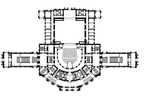Burgtheater
Gottfried Semper, Carl v. Hasenauer
alias K.K. Hof- und Nationaltheater (Imperial Court- and National Theatre, 1888–1918), Burgtheater / Hofburgtheater, Imperial Court Theatre, Theater nächst der Burg (Theatre near the Castle, 1741–1888)Dr. Karl-Lueger-Ring 2 | |
| show on the map | http://www.burgtheater.at/Content.Node2/home/index.php |
Important events
Today’s Burgtheater as such was founded on 14 March 1741 under the reign of Empress Maria Theresia, who wanted a theatre close to her imperial palace (Hofburg). Her son and the next Austrian Emperor Joseph II named it German National Theatre in 1776.
On 14 October 1888 the theatre moved to its today’s building at Ringstrasse. The building was designed by Gottfried Semper and Karl Freiherr von Hasenauer. These two architects also designed the New Hofburg and the twin museums in Vienna: Naturhistorisches Museum (Museum of Natural History) and Kunsthistorisches Museum (Museum of Art History).
At the end of World War II, on 12 March 1945, Burgtheater building was heavily damaged in a bombing. One month later there was a fire which caused further damage.
People
History
The conversion of the Ball House, a stable-like building used for ball games as early as during the reign of Emperor Ferdinand I (1503–1564), was undertaken in 1741. With provisional alterations, this ‘Königliche Theater nächst der Burg’ (Royal Theatre at the Castle) initially served as a branch for the Corinthian Gate Theatre. It was only in 1743 that the theatre’s leaseholder, Joseph Carl Selliers, redesigned the house. Over the years several extensions to the building became necessary, all of them towards the summer riding school, the prestigious main front facing Michaelerplatz. In 1760 court architect Nicolaus von Pacassi furnished the exterior with three high arched windows and a decorative gallery. The stage part and the main elevation facing the Michaelerplatz remained unchanged until the building’s demolition.
In 1776 Emperor Joseph II, who regarded the theatre as a moral institution and a means of achieving social reforms in terms of the Enlightenment, ordered that a national theatre be established. From that year on the theatre’s economic and administrative aspects were assigned to the court. In 1779 and 1794 further modifi cations to the auditorium were carried out by court architect Joseph Hillebrandt. Some hundred years aft er that in October 1888, however, the installation of fi re safety precautions necessitated the theatre’s temporary closure. Only a few days later, after a fourteen year planning and design stage, the (new) Burgtheater was opened, thus completing the magnificent buildings of Vienna’s Ringstrasse, a landmark town planning project and the greatest of its time in Europe. The plans for the Kaiserforum (Emperor’s Forum), which was to consist of two museums and the eastern hemispherical wing of the new Castle, were scaled down. Emperor Franz Joseph I designated today’s Burgtheater site, which is an architectural counterpoint to the Parliament, City Hall and the University.
Gottfried Semper and Karl Hasenauer were commissioned as architects for the theatre, Semper above all elaborating the lay out and interior design, while Hasenauer was in charge of the formal appearance, architectural details and the sumptuous decoration. Aft er construction of the Royal Hoft heater (Court Theatre) in Dresden, Semper became a much sought-aft er theatre architect. His renown was even enhanced aft er the original structure was replaced by the celebrated Opera House (1871–1878). At that time, however, he had, aft er some travels, already fi nally moved to Vienna to devote himself fully to designing the Ringstrasse, a large scale project which in terms of style indulged in historicism.
The Burgtheater itself, built in Neo-Baroque style, is the monumental embodiment of the late Ringstrasse era, whose maxim was ostentatiousness over reason and practicality. Also, there were to be ascending boxes, galleries and tiers refl ecting aristocratic and courtly principles. However, when designing the auditorium, Hasenauer made a number of fundamental constructional mistakes. The lyre-shaped arrangement of the boxes proved to be unfavourable both for acoustic and visual reasons, resulting in an imbalance between the relatively small floor space and the room’s height, as well as the dizzying arrangement of the fourth gallery. These shortcomings were altered by Emil von Förster in 1898, who left out the lyre-shaped box configuration and completely redesigned the fourth gallery and side rooms. The artistic decoration of the theatre’s interior was undertaken primarily by the art studio of the Klimt Brothers and Franz Matsch. Young Gustav Klimt is the author of the ceiling painting In front of the Theatre in Taormina. The artist, who a decade later was to become a leading fi gure and president of the Vienna Secession had not yet embarked on his characteristic Secession decorative brushwork.
On 12th March 1945 the Burgtheater was hit by a bomb, and a month later a fire destroyed both the stage and the auditorium, whose iron construction, installed by Hasenauer in a technically advanced way, survived unscathed and proved to be invaluable in the house’s rebuilding. In the meantime, the Burgtheater found refuge in the Ronacher immediately aft er the cessation of hostilities, presenting the premiere of Grillparzer’s Sappho on 30th April 1945, with the reconstruction continuing to around 1950. Architects Michael Engelhart and Otto Niedermoser were commissioned to redesign the house, the former working on the auditorium’s restoration, and Niedermoser on the proscenium. In addition, the theatre was equipped with state-of-the-art technology including a revolving stage by Sepp Nordegg. 15th October 1955 saw the state opening of the new Burgtheater, symbolising the recovery and identity of the Republic of Austria.
Tags: Neo-Baroque, Belle Époque, detached building, prestige building
Authors: Brigitte Marschall, Fritz Trümpi
Additional information
No information has yet been entered
Add information

































